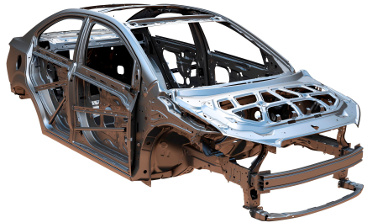 |
| April 05, 2016 | Volume 12 Issue 13 |
Designfax weekly eMagazine
Archives
Partners
Manufacturing Center
Product Spotlight
Modern Applications News
Metalworking Ideas For
Today's Job Shops
Tooling and Production
Strategies for large
metalworking plants
Metals:
There's nothing like a good crisis -- how the spark of urgency benefits innovation
Steelmakers are rising to challenges from other automotive materials.

By Craig Parsons, President of Automotive, NanoSteel
History demonstrates time and again that humans often do their most innovative work when they are under the greatest pressure. Take the Allies' development of the P-51 airplane, which allowed their bombers to fly escorted all the way to Germany and back during World War II: the craft was conceived, designed, and built in about six months. Or the Russian launch of Sputnik that galvanized the U.S. space effort -- culminating in an American win in the race to put the first man on the Moon.
War and competition are not the only sources of innovation-producing pressures: Budget cuts can be very effective motivators, too. Look at NASA's shrinking resources in recent years. These have opened the door to private aerospace to come up with more cost-effective ways to supply the Space Station.
In the automotive industry, it was the 2012 announcement of much stricter fuel-economy standards for 2025 that shook up the OEMs. This watershed moment produced ripples that continue to widen for materials providers, carmakers, and suppliers alike -- even as gas prices at the pump fall.

A car body-in-white in advanced lightweight steel.
Why? Because while the U.S. government is demanding more efficient vehicles that take less of a toll on the environment, consumers still want large, comfortable cars with all the latest technological bells and whistles that can add on even more weight. Suddenly, "lightweighting" has become critical, thrusting steel -- which still makes up the largest percentage of material used in most vehicles -- onto a much more competitive playing field as aluminum and composites jostle for a weight-saving share of vehicle composition.
Although steelmakers have been working closely on product development with automotive OEMs all along (more than half the grades in cars today didn't even exist 15 to 20 years ago), the industry has definitely been given notice that times are changing.
I believe that in order to meet the competition of other materials, the automotive-steel industry needs to accelerate both the development and introduction of new solutions into the marketplace. This will not only benefit the steel industry itself but also automakers and ultimately consumers -- with more technologically advanced, manufacturing-friendly, and cost-effective options.
The coming generation of advanced high-strength steels (AHSS) will secure an ongoing role in the bodies of the newer, lighter cars. With fundamental advantages over other materials, novel attributes that are attractive to producers and consumers alike, and a reassuring familiarity based on over a century of quality production, steel will still be the answer at the core of the majority of vehicles in 2025.
Emerging from research at the Idaho National Laboratory, the AHSS steels we're developing are cost efficient to manufacture with unique combinations of high strength and formability not normally associated with steel. What's more, our steels are designed to be manufactured into parts on existing stamping and assembly lines. Automakers can keep using their current production infrastructure, and employees won't need retraining.
Now I'm not saying that other materials can't play a role in vehicle lightweighting. In fact, they are already making positive contributions. But they also have their drawbacks.
Aluminum, for example, is currently something of a challenge to incorporate on the factory floor; you must be careful to not mix aluminum and steel scrap, and this segregation may require scrap-handling modifications. Also, owners of cars and trucks made with aluminum are already finding that not every garage is equipped to handle the material, which is more expensive to repair than steel.
Composites require highly specialized manufacturing setups and are typically more costly to produce in quantity. In many cases, they require a significant modification to the assembly process to fixture into a vehicle; simple welding of steel often has to be replaced by new or expensive adhesives when composites are used.
The urgency of the push for lighter vehicles has amped up the pressure on automakers to get it right. And the latest generation of steels is on its way to commercialization, with distinct advantages over competing materials. These attributes will help sheet-steel manufacturers, and OEMs, answer the call for cost-effective ways to raise fuel economy, while keeping the consumer happy, safe, and confident in the integrity of the vehicles they are driving.
SIDEBAR: Designing alloys for use with existing manufacturing processes and equipment
NanoSteel takes common raw material constituents used to make conventional steel alloys and combines them in different ratios to create proprietary alloy chemistries.
In conventional steel, the grains and matrix that comprise the structure of the steel are measured in microns. NanoSteel's alloys are nano-structured, which means grain and matrix sizes smaller than 100 nanometers. These nano-scale microstructures produce unique mechanical and physical properties resulting in capabilities outside the known performance boundaries of existing steels.
NanoSteel's technology is a "bulk materials nano-technology," which means that raw material chemistries are composed of conventional-size constituents that do not contain any nano-size particulates. Only the post-production microstructure of the thermal spray coatings, weld overlays, powder metals, and sheet steels are nano-scale in size.
NanoSteel bases the material chemistries of its patented alloys on iron, providing a competitive cost advantage given its abundance and recyclability. The company does not use any expensive, rare, or exotic constituents.
NanoSteel follows a market-driven product development model so that basic laboratory discoveries are commercialized for large-scale industrial implementation. After selecting a material chemistry that meets a desired set of properties, NanoSteel simulates actual production processes in the laboratory so that subsequent production and performance validation trials lead to a successful product launch. All NanoSteel alloys are designed for use in mainstream industries with existing manufacturing processes and widely available commercial application equipment.
Learn more at nanosteelco.com.
Published April 2016
Rate this article
View our terms of use and privacy policy
